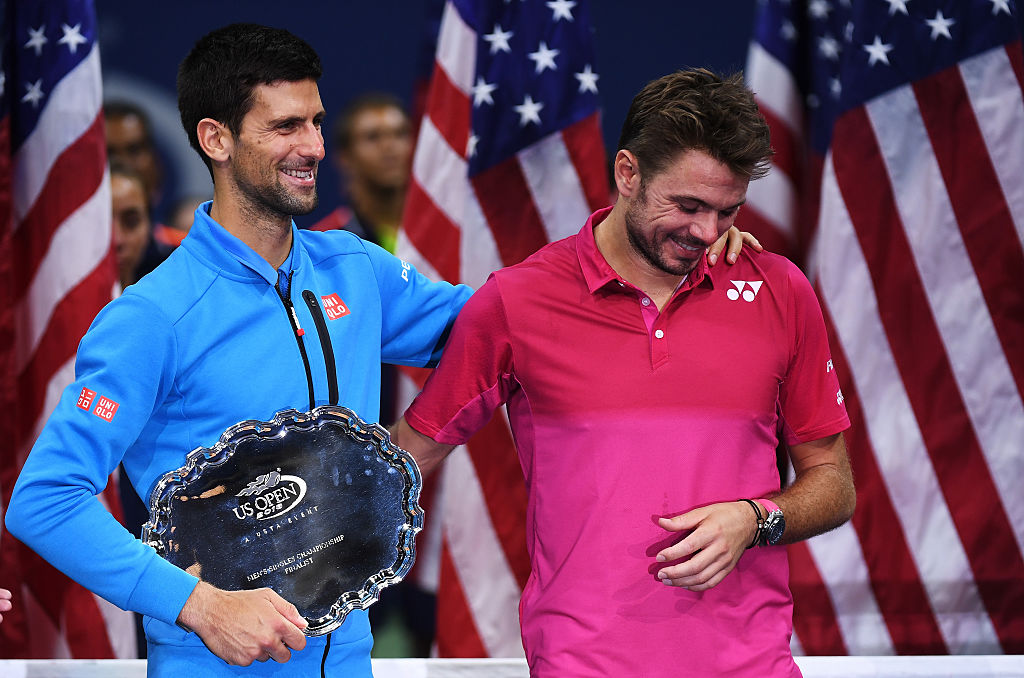Is Stan The Man To Stop Djokovic?
/Only with the passing of time will we know if the Rotterdam final between Gael Monfils and Stan Wawrinka was consequential or not.
It was won by Monfils, but I don’t think anyone was viewing it as some kind of quantum leap for him, because Monfils’ whole career has been one big tease. He’s given us glimpses of the upper extremities of his talent, but left most of it to our imagination. There’s always been a disconnect between what he produces in bursts, and what he produces over the course of a season. The sad part is that injury has had a lot to do with that. But application and desire have come into it too. He’s an enigma; an entertaining one, but a frustrating one.
Gael Monfils smashes a forehand return as he jumps in the air.
Whereas Stan Wawrinka is the real thing. Unlike Monfils he’s converted his potential into action and into Grand Slam titles. He’s also earned his status as a crowd favourite. Part of this comes from the experience of watching him play: nobody else hits thunderclap groundstrokes like him, and what’s not to love about high-risk power tennis? Part of it comes from the fact that he manages to play so well despite having a burly frame, looking a bit dishevelled, walking onto court with bed hair, and sun cream across his nose that hasn’t been properly rubbed in.
The overwhelming feeling as I watched Wawrinka tear through the field in Rotterdam to reach his first final in almost two years, was joy. This stemmed from having witnessed his recent plight. On the podcast, Catherine described the grim scene in Eastbourne last summer when an ailing Wawrinka was thrashed by an ailing Andy Murray. The Wawrinka we’ve come to know is a force, and he just didn’t appear to have the same strength anymore. David put it so well: “He looked like he was on somebody else’s legs. They didn’t seem to belong to him.” But he’s moving freely again now, and the rest of his tennis is beginning to follow.
Stan Wawrinka returns a forehand to Gael Monfils in the Mens Final in Rotterdam.
I sensed that most people felt the same pleasure in seeing Wawrinka look more and more like his old self. But I couldn’t stop thinking about Novak Djokovic in all this. How must he have been feeling?
At this point it’s worth noting that Djokovic and Wawrinka are good friends, and I’ve no doubt that a big part of Djokovic was genuinely pleased to see the Swiss healthy again. It’s also worth remembering that Djokovic stands on the verge of a mammoth achievement: winning all four Grand Slams in a row for the second time in his career. While a lot could happen between now and Roland Garros, if Djokovic stays fit, he will go to Paris with history on the line.
This is the context into which Wawrinka re-enters the fray as a genuine force in the game, and it’s significant because arguably nobody poses a bigger threat to Djokovic at a Grand Slam than Wawrinka in full-flight. Roger Federer hasn’t beaten Djokovic in a Grand Slam since 2012. Rafael Nadal hasn’t done it off clay since 2013. Juan Martin del Potro has never done it. Wawrinka has done it three times since the start of 2014.
I suppose Nadal will always be the biggest roadblock for Djokovic at Roland Garros. But that match-up is actually not a bad one for Djokovic. If he loses to Nadal in Paris it will simply be because of the Spaniard’s greatness and pedigree on clay.
Novak Djokovic and Stan Wawrinka after the 2016 US Open final.
Wawrinka represents a different threat altogether. Djokovic leads their head-to-head 19-5. But something comes over Wawrinka when they meet at Grand Slams: their record is tied at 3-3 on the biggest stage since Wawrinka bloomed in 2013. Conventional wisdom suggests that there is no way to breach Djokovic’s defence on slow surfaces, but Wawrinka has repeatedly found a way to smash through. Nobody can make Djokovic look more forlorn, limp, ragged, dazed, and even a little impotent, than Wawrinka when he’s pummelling his groundstrokes.
These are the matches when Wawrinka punctuates winners with guttural cries, when he points to his head to signal his intense focus, when he morphs into the best version of himself.
These are the matches when Wawrinka demonstrates that he’s more than just brute power, that he has an ability to hustle and scramble with the best of them, that his kick serve is un-attackable, that his chip return can give him a foothold in rallies, that he understands the contours and texture of five-set contests.
These are the matches when the rousing effect of Wawrinka’s tennis becomes apparent, the kind of tennis to bring spectators to their feet, to render commentators speechless, or to make them come out with gasps and laughter at every turn.
If you’ll forgive a far-fetched analogy, think of Djokovic and Wawrinka as snakes. Djokovic is a constrictor: engineered to outlast, he gradually tightens his grip on matches, starves opponents of what they desire, and then swallows them whole. Wawrinka, on the other hand, is of the venomous variety: he strikes at opponents, often missing spectacularly, but knowing that when he does connect, his bite will be more potent. But when he plays Djokovic at Grand Slams, Wawrinka manages to assume the best qualities of constrictors too. His tennis becomes even more muscular, and he becomes physically stronger.
I’ve been watching highlights of their epic series of Grand Slam duels all week on YouTube. It’s been so much fun. The one that stands out will always be their 2015 French Open final. Djokovic had won his last 28 matches, but Wawrinka wrestled this one from him with untouchable tennis. I still can’t get my head around the fact that Djokovic managed to recover and win Wimbledon just a month later. Wasn’t he inexorably haunted by the experience of that final? Did he not wake up in the middle of the night to see Wawrinka’s backhand winners flashing before his eyes?
In terms of consistently producing excellent matches, no rivalry has been better over the past five or six years than Wawrinka vs. Djokovic. Owing mostly to injuries, they’ve not actually met since the US Open final of 2016. If the tennis gods are smiling down on us, they’ll put that right soon. And you won’t want to miss it.










